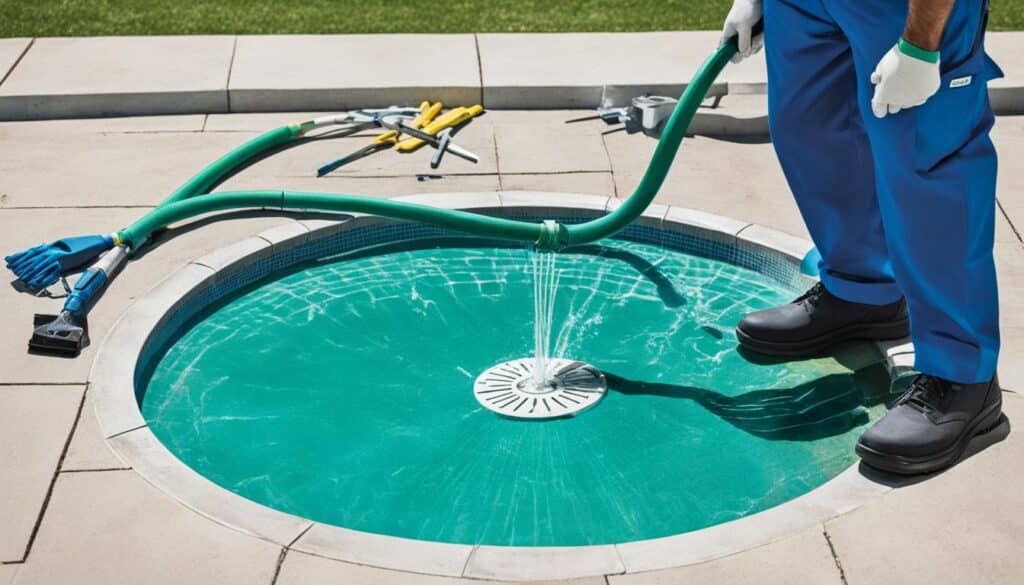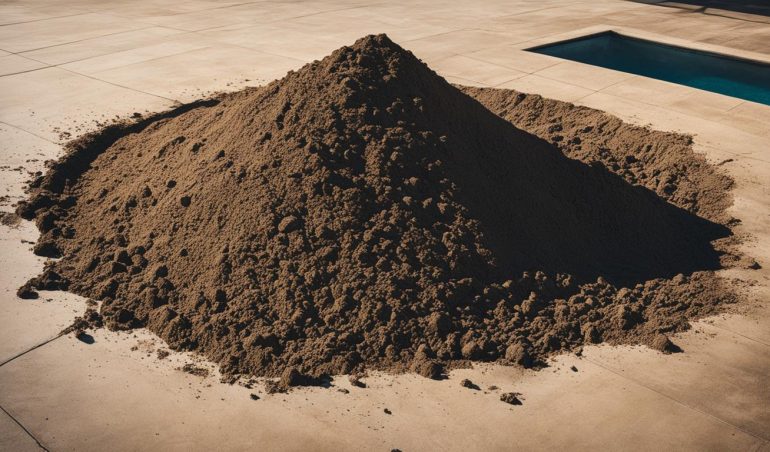Filling in a swimming pool can be a significant project that requires careful planning and budgeting. Homeowners may choose to fill in a pool for various reasons, such as safety concerns, high maintenance costs, or a desire for more outdoor space. However, before embarking on this endeavor, it is essential to understand the cost implications involved.
The cost to fill in a pool can vary depending on several factors. These factors include the type and size of the pool, the chosen fill material, the cost of draining the pool, and the labor required for removal. Each of these factors contributes to the overall cost, and it is crucial to consider them when planning for pool removal.
Key Takeaways:
- The average cost to fill in a pool ranges from $2,700 to $19,000, with a national average of $6,000.
- The cost is influenced by factors such as pool type, size, material, fill material, pool draining, and labor.
- Hiring a professional is recommended for pool removal to ensure safety and compliance with permit requirements.
- The specific cost breakdown will depend on individual circumstances and preferences.
- Proper planning and budgeting are crucial when considering pool removal.
Factors Affecting the Cost to Fill In a Pool
The cost to fill in a pool depends on several factors that homeowners should consider when planning for pool removal. By understanding these factors, individuals can budget accordingly and make informed decisions about the pool removal process.
Pool Size: The size of the pool plays a significant role in determining the overall cost of filling it in. Larger pools require more fill material, resulting in higher costs. Homeowners with larger pools can expect to pay more to fill in their pool compared to those with smaller pools.
Pool Type: The type of pool, whether it is inground or above-ground, can also affect the cost of pool removal. Inground pools generally have higher removal costs due to the complexity of the process. Above-ground pools, on the other hand, tend to be less expensive to fill in.
Pool Material: The material that the pool is made of, such as vinyl or concrete, can impact the cost of pool removal. Vinyl pools typically require complete removal, which can result in higher costs. Concrete pools, on the other hand, can be partially or completely removed, providing homeowners with more flexibility in terms of cost.
Fill Material: The type of fill material used to fill the pool after removal can affect the overall cost. Common fill materials include gravel, dirt, fill sand, topsoil, and concrete. The cost of each fill material can vary, with some options being more affordable than others.
Pool Draining: Before pool removal can begin, the pool needs to be drained. The cost of draining the pool can vary depending on the specific requirements and considerations of the pool, as well as any local regulations that need to be followed.
Labor: The labor required for pool removal contributes to the overall cost. Factors such as the size of the pool, access to the pool location, and the number of workers needed can impact labor costs. It is important to budget for labor expenses when calculating the cost of filling in a pool.
Understanding these factors and their impact on the cost of filling in a pool will help homeowners plan ahead and make informed decisions. By considering pool size, type, material, fill material, draining, and labor costs, individuals can budget accordingly and ensure a smooth pool removal process.
Pool Types and Size
The size and type of the pool play a significant role in determining the cost to fill it in. The size of the pool is measured in cubic yardage, which is calculated by multiplying the length, width, and depth of the pool. Inground pools are generally more expensive to fill compared to above-ground pools. The cost also varies depending on the specific dimensions of the pool. For example, filling in a 12×24 inground pool can cost anywhere from $2,100 to $6,700, while filling in a 15×30 inground pool can range from $2,500 to $8,100.
The pool size and type are key factors to consider when estimating the cost to fill in a pool. Inground pools, typically made of materials such as concrete or fiberglass, require more extensive removal and fill. This translates to higher costs compared to above-ground pools made of materials like vinyl or metal.
Let’s take a look at some examples to illustrate the cost differences based on pool size and type:
- 12×24 Inground Pool: Filling in a pool of this size can cost between $2,100 and $6,700, depending on various factors such as location, fill material, and labor costs.
- 15×30 Inground Pool: The cost to fill in a pool of this size ranges from $2,500 to $8,100, taking into account factors like the depth of the pool and the accessibility of the property.
These are just two examples, but it’s important to note that the cost can vary significantly based on the size and type of the pool. When considering pool removal or fill-in, it’s recommended to consult with a professional to get an accurate estimate based on your specific pool dimensions and requirements.
Pool Material and Fill Material
The material of the pool itself can significantly impact the cost of filling it in. Different pool materials require different removal processes, resulting in varying costs. For instance, vinyl pools typically require complete removal, which can range from $3,000 to $10,000. Fiberglass pools also necessitate complete removal and can cost between $5,000 and $15,000. On the other hand, concrete pools can either be partially or completely removed, with associated costs ranging from $3,000 to $15,000.
Once the pool is removed, the next step is to fill it in with suitable material. The fill material used can include options such as gravel, dirt, fill sand, topsoil, or concrete. Each material option has its own average cost, which will be discussed in more detail later in this guide.
To get a better understanding of the pool removal process and how different pool materials impact the overall cost, refer to the comprehensive guide below.
Pool Draining and Labor

When it comes to filling in a pool, draining the pool beforehand is an essential step that incurs an additional cost. This typically involves renting or buying a submersible water pump to remove the water from the pool. The cost of draining will depend on the specific requirements of the pool and the regulations set by the municipality.
Aside from draining, labor costs for pool removal are another significant factor to consider. The cost of labor can vary based on various factors, including the size of the pool, the accessibility of the pool, and the number of workers required for the job. Homeowners can expect to pay anywhere from $1,000 to $4,000 for labor costs when filling in a pool.
Additional Costs and Considerations
In addition to the main cost factors mentioned earlier, there are several additional costs and considerations to keep in mind when filling in a pool.
One important factor is the cost of permits. Pool removal projects often require permits, and the cost and requirements for these permits can vary depending on your location. It is essential to research and understand the permit process in your area to avoid any legal issues or delays.
Debris removal is another consideration. When removing a pool, there will be excess material, such as concrete, debris, or other materials, that need to be disposed of properly. Renting a dumpster for debris removal can help keep your property clean and organized throughout the pool removal process.
When deciding to fill in your pool, you will also need to consider whether you want a partial fill-in or full pool removal. Partial fill-in involves demolishing the pool to a certain point and filling the remaining space with sand, gravel, or other suitable fill material. Full pool removal, on the other hand, requires complete demolition and removal of all pool components.
In some cases, the expertise of a structural engineer may be necessary. This is particularly important if you plan to build any new structures on the area previously occupied by the pool. A structural engineer can assess the stability of the ground and provide recommendations for any necessary reinforcements.
If your pool has a deck or enclosure, its removal may also incur additional costs. The complexity and materials used in the deck or enclosure will determine the cost of removal.
Lastly, after the pool removal process is complete, you may need to consider landscaping and restoration. This can include repairing any damage caused during the removal process, reseeding the area, or replanting trees and shrubs to restore your outdoor space.
Considering these additional costs and factors can help provide a more accurate estimation of the total cost to fill in your pool and ensure a smooth and successful pool removal process.
Cost to Fill In a Pool by Type of Fill
The cost of filling in a pool can vary based on the type of fill material used. Different materials have different costs, so it’s important to consider your budget and the desired outcome when choosing the right fill material.
Gravel
Gravel is the most affordable option when it comes to filling in a pool. It typically costs between $5 and $8 per cubic yard. Gravel is a popular choice because it is easy to obtain and provides a stable base for the pool area.
Dirt
Dirt is another commonly used fill material for pool removal. It has a cost range of $8 to $12 per cubic yard. Dirt is a versatile material that can be easily leveled and compacted, making it a cost-effective choice for filling in a pool.
Fill Sand
Fill sand is a slightly more expensive option, with a cost ranging from $15 to $40 per cubic yard. It is a fine-grained sand that is commonly used in construction projects. Fill sand provides a stable base and good drainage, making it suitable for pool filling.
Topsoil
If you’re looking to create a fertile ground for landscaping after pool removal, topsoil may be the right choice. However, it comes with a higher cost compared to other materials, ranging from $12 to $55 per cubic yard. Topsoil is rich in nutrients and supports the growth of plants, but it may require additional soil amendments for optimal results.
Concrete
Concrete is the most expensive fill material with a cost range of $100 to $200 per cubic yard. This option is typically used when a solid and stable surface is desired, such as for building a patio or foundation. Concrete provides durability and can withstand heavy loads.
When selecting a fill material, consider factors such as cost, stability, drainage, and intended use of the filled area. Consulting with a professional can help you determine the best fill material for your specific needs.
Conclusion
Filling in a pool can be a significant project with various cost factors to consider. The average cost to fill in a pool ranges from $2,700 to $19,000, with the national average being $6,000. The overall cost is influenced by factors such as pool type and size, pool material, fill material, pool draining, and labor.
When it comes to pool removal, homeowners should carefully assess the specific factors that affect the cost. The type and size of the pool play a significant role, with inground pools typically having higher removal costs compared to above-ground pools. The material of the pool, whether it be vinyl, fiberglass, or concrete, also impacts the cost. Additionally, the choice of fill material and the cost to drain the pool add to the total expense.
To ensure a safe and compliant pool removal process, it is recommended to hire a professional. Professionals have the expertise to handle the demolition and removal safely, as well as navigate any necessary permits. By understanding the cost factors involved and budgeting accordingly, homeowners can make informed decisions about filling in their pools and creating a new outdoor space.
If you need more of your questions answered from our Solar Safe Pool Covers experts in the Phoenix and Tucson, AZ metro areas contact us today.
FAQ
How much does it cost to fill in a pool?
The cost to fill in a pool can range from $2,700 to $19,000, with the national average being $6,000.
What factors affect the cost to fill in a pool?
The cost to fill in a pool is influenced by factors such as the pool type, size, material, fill material, pool draining, and labor.
How does the pool type and size affect the cost to fill it in?
Inground pools generally have higher removal costs compared to above-ground pools. The size of the pool also affects the cost, as larger pools require more fill material.
How does the pool material and fill material impact the cost?
The material the pool is made of, such as vinyl, fiberglass, or concrete, can impact the cost of removal. The chosen fill material, such as gravel, dirt, fill sand, topsoil, or concrete, also contributes to the overall cost.
Is draining the pool and labor costs included in the overall cost?
Draining the pool before removal and labor costs for pool removal are additional factors to consider and may incur extra costs.
Are there any additional costs or considerations when filling in a pool?
Yes, additional costs can include permits, debris removal, the need for a structural engineer, pool deck or enclosure removal, and landscaping or restoration after the pool is filled in.
What is the cost to fill in a pool with different types of fill materials?
The cost to fill in a pool can vary depending on the type of fill material used. Gravel is the most affordable option, while concrete is the most expensive.
What is the average cost to fill in a pool?
The average cost to fill in a pool ranges from $2,700 to $19,000, with the national average being $6,000.






